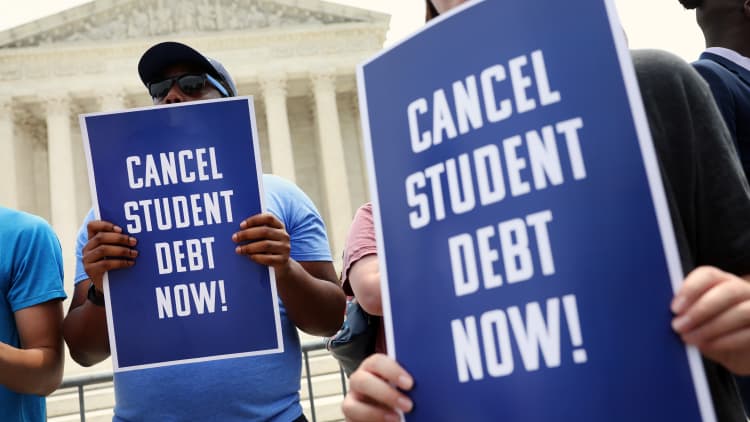Hero Images | Hero Images | Getty Images
Even before the Supreme Court blocked President Joe Biden’s plan to forgive student debt, fewer students were enrolling in college.
Nationwide, enrollment has lagged since the start of the Covid-19 pandemic, when a significant number of students decided against a four-year degree in favor of joining the workforce or completing a certificate program instead.
But this fall, freshman enrollment continued its slide, sinking 3.6%, according to the National Student Clearinghouse Research Center. The declines were most pronounced in bachelor’s programs at public and private four-year institutions.
“The debate about the value of college continues,” said Rick Castellano, a spokesperson for education lender Sallie Mae.
Completion rates are at a standstill
Six-year college completion rates have also stalled after years of steady growth, a separate National Student Clearinghouse Research Center report found. Only about 62% of students who started college in 2017 have graduated, essentially unchanged since 2015. Nearly one-third, or 29%, of all students who started that year have stopped out, or put their education on hold.
“This is more bad news for four-year colleges,” said Doug Shapiro, the National Student Clearinghouse Research Center’s executive director.
“Not only have fewer of the 2017 starters completed as of 2023, but the data also show fewer still enrolled, suggesting that this is more than just a matter of slower progress during the pandemic years,” Shapiro said.
How student debt has influenced enrollment
Higher education, as a whole, is under pressure, Shapiro said. Rising college costs and ballooning student debt balances have caused more students to question the return on investment.
Among recent “stopouts,” most said they put their education on hold due to financial obstacles, including the costs of programs, inflation and the need to work, a separate report by Lumina and Gallup found.
To that end, low-income students are the most likely to opt out.
Research suggested that Biden’s promise to forgive up to $20,000 in debt might have made it more likely that previously unenrolled students would reenroll.
However, that relief never came and now there is a new plan in the works.

It may be too early to tell the effect that could have on enrollment going forward, Shapiro said.
But increasingly, borrowers are struggling under the weight of education debt, which today totals more than $1.7 trillion.
For those who don’t get a degree, managing such a hefty amount of debt is especially difficult.
Among borrowers who start college but never finish, the default rate is three times higher than the rate for borrowers who have a diploma.
“Broad-sweeping debt forgiveness may not be on the table but there are other programs the Biden administration has implemented,” Castellano said.
Already, Biden has managed to erase $127 billion in education debt for more than 3.5 million borrowers, largely through Public Service Loan Forgiveness and income-driven repayment plans.
“There are still options for students and families to reduce their payments and eventually get their loans forgiven,” Castellano said.
Subscribe to CNBC on YouTube.
 EU News Digest Latest News & Updates
EU News Digest Latest News & Updates



